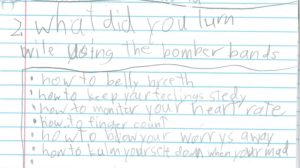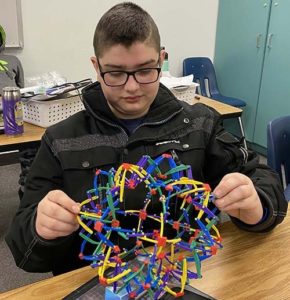Students See and Feel How Heart Rate Drives Feelings and Behaviors Throughout the School Day
Heart rate monitors allow schools to take a two-fold approach to student and faculty wellness, addressing both physical fitness and emotional health using the same device.
Wearing the IHT ZONE monitor, students and teachers alike at Braham Area (Minn.) Elementary School know when to push themselves to get their heart rates up and when to use school social worker Jonelle Klemz’s breathing strategies to calm down when emotions run high.
By the end of the school year, Klemz will have worked with every student and teacher on the campus. She spends a week in each classroom introducing the IHT ZONE heart rate monitor and teaching breathing techniques designed to help quickly lower heart rates when they become elevated.
“This gives you a chance to learn that about yourself,” Klemz said. “So I tell them they are scientists this week and you’re studying yourself. You get to see how different things feel.”
Identifying Emotional Triggers Throughout the School Day
Heart rate is the most reliable indicator that a student may be dealing with heightened emotions, excitement, or anxiety. Klemz said many students – and teachers – experience both stress and anxiety at school and need to learn how to better manage those feelings.
At the end of each day, Klemz collects the heart rate monitors from the students and reviews a graph that shows each student’s graph throughout the day. Klemz sees when the student’s heart rate became elevated and asks the student to talk about what was happening at the time.
 “It’s fun to hear 8, 9, 10 year olds say ‘I think I went in the yellow because I was doing hard math work’ or ‘I was definitely in red because I was running at recess,’” she said. “To see them start to understand themselves….”
“It’s fun to hear 8, 9, 10 year olds say ‘I think I went in the yellow because I was doing hard math work’ or ‘I was definitely in red because I was running at recess,’” she said. “To see them start to understand themselves….”
Sometimes students struggle with the stress of doing their everyday school work. Klemz got buy-in from her teaching colleagues up front, and the teachers now have direct evidence as to when students feel stress. That knowledge helps them explain the program to teaching assistants who haven’t seen heart rate monitors used outside of PE class.
“We had (an instructional assistant who works 1:1 with a third-grader) tell the teacher that she didn’t think the monitor worked,” Klemz said.
The assistant works with a student who seems uninterested and inactive throughout the day, but at the end of the day, his graph showed quite a bit of time with his heart rate elevated into the yellow zone.
“She asked the teacher, ‘why is that if he’s just sitting there and looks half asleep? That’s not accurate,’” Klemz said. “The teacher told her, ‘I think they are very accurate, and I think you’re underestimating how stressed this student is just doing the regular work on a daily basis. Work is really hard for him.’ The assistant said she’d never thought of it that way before. So now she’s totally bought into how it shows where the students are. Some are pretty stressed doing the work.”
Putting Calming Techniques into Practice
Braham’s program focuses on teachers as well. They wear the IHT ZONE heart rate monitors and practice the same breathing techniques:
- Expand and contract Hoberman spheres as they breathe in and out
- Navy Seals Box Breathing: inhale and hold for 4 seconds, exhale and hold for 4 seconds
- 5-finger breathing: students trace their fingers as they breathe in and out
- Crossing arms across the midline and tapping shoulders.
 Most importantly, Klemz said, students see that teachers also deal with stress during the day and take the same steps to calm themselves down.
Most importantly, Klemz said, students see that teachers also deal with stress during the day and take the same steps to calm themselves down.
“I looked at a third-grade teacher the other day and he was sitting there, arms crossed, just breathing,” Klemz said. “What a healthy thing to be role-modeling to our kids. And they are all surprised how taking 2-3 minutes of quiet, calm breathing can reset your whole day.”
While working with a fourth-grade class, the students made sure to tell Klemz that their teacher had spent time in the yellow zone – which indicates an elevated heart rate either due to moderate physical activity or heightened emotions such as excitement, frustration or worry – during a class discussion.
“The teacher said she didn’t know she was in yellow at the time, but then she explained why she was in yellow,” Klemz said. “They were having a very serious discussion about a problem in the classroom with a lot of kids swearing. She was really being firm about it and that’s when they saw her monitor go to yellow.
“The teacher told them it’s a good learning opportunity because they knew she was very serious and the situation was stressing her out,” Klemz said. “She was able to role model some of the breathing and other techniques to bring her heart rate back down. It’s good learning overall.”
Viewing Heart Rate Beyond Physical Activity
Schools use IHT ZONE heart rate monitors several ways:
- Emotional management programs such as Braham’s,
- Physical education programs to encourage students to reach goals for time spent exercising at a moderate to vigorous level, and
- In STEM learning classrooms to promote physical activity and
Klemz began teaching her breathing techniques years ago but added heart rate monitors for the 2021-22 school year. To test her students’ understanding of the concept, she asked them to talk her through the breathing techniques to help her calm down. Looking at her personal heart rate monitor, the students saw her heart rate calm within moments after she started breathing to calm down.
“That got me thinking,” Klemz said. “If they got that excited seeing my heart rate go down, how excited would they be to see it for themselves?”
On a Thursday afternoon in spring 2021, Klemz searched “heart rate monitors for school” in Google and found IHT. She connected with a representative, got some key information. Klemz’s research also led her to an NBC Today Show segment that profiled a Littleton, Colo., elementary school using IHT’s heart rate monitors in its counseling department. By the following Monday, she had put together a proposal for the nearby Grandy Lions Club. After her presentation, the club promptly gave her the funding to buy a set of monitors and a charging case.
Seeing the Emotional and Physical Benefits of Exercise
Through Klemz’s doesn’t focus specifically on PE classes, she said the campus PE teacher has noticed students working harder than they did before they started wearing the IHT ZONE monitors.
“She sees some of the kids who maybe aren’t excited about PE or don’t really like to move working extra hard,” Klemz said. “They want to see if they can get their heart rate into the red. I’m excited about that too with so many kids sitting in front of screens.”
Her excitement grows when she sees teachers incorporating physical activity breaks into their classroom learning. Working with one class, she noticed that every student’s heart rate spiked at the same time when they weren’t scheduled to be in their PE class.
“I asked the teacher if he had given a test at that time,” Klemz said. “He asked the class if they remembered. With a little prompting, I learned he had them get up from their desks and do some jumping jacks and get really active.”
Teachers understand how students respond to vigorous physical activity and are using it more and more to promote emotional wellness as well as academic readiness.
“The teachers are learning to use that as a tool to help generate good learning for the rest of the day,” Klemz said. “When you work your heart out really hard during the day, it’s going to help you manage those feelings and manage the hard work we have to do. School is supposed to be hard. That’s part of the growth mindset. We have to move our bodies because it helps our learning.”
The success she’s seen has given Klemz new energy to do her job even as students deal with pandemic-related challenges. The technology helps her connect with every student on campus while giving teachers a new way to talk about Social-Emotional Learning on campus.


